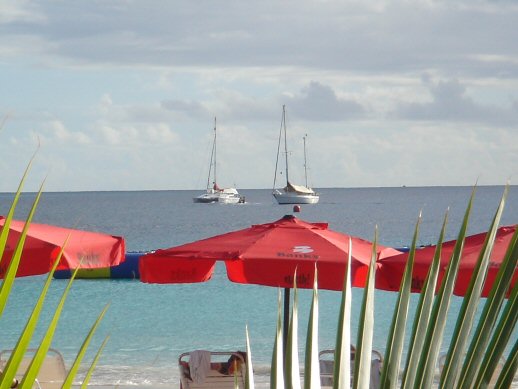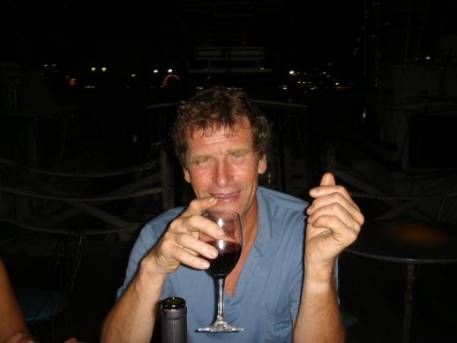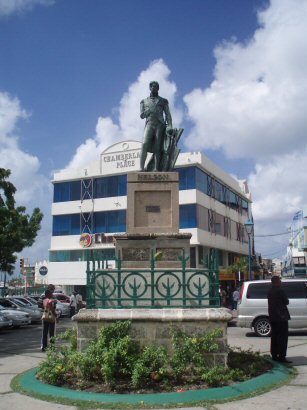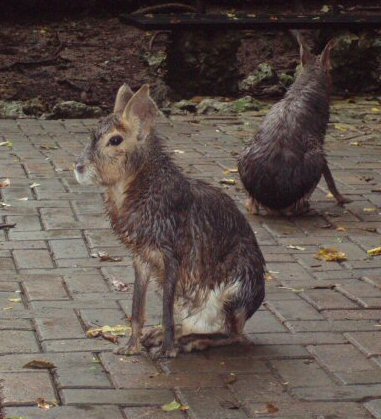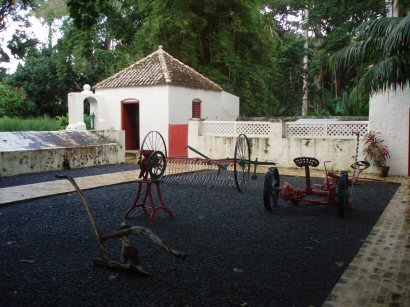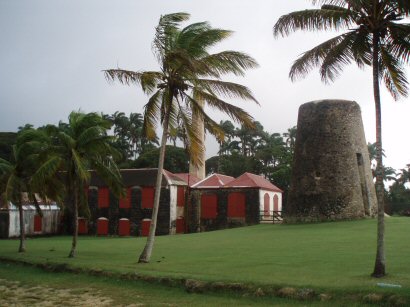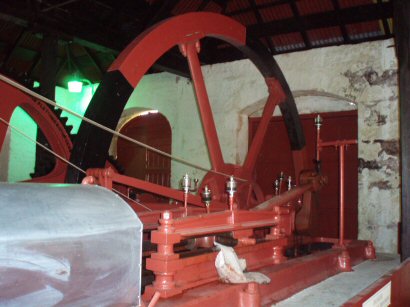Rum and Fun in Barbados

8 – 14 December 2007: Barbados
As our engine was still a little fragile, we decided to clear in to Barbados at Port St Charles, a marina on the north west of the island near Speightstown. There was an anchorage area outside the entrance to the marina that we assumed would be empty so we’d have plenty of space to anchor Rahula under sail if the engine died again. The alternative was to sail to Carlisle Bay in Bridgetown, which is the main yacht anchorage and therefore probably very full, with little space to manoeuvre. There was only one other boat outside Port St Charles, a huge luxury motor yacht, and luckily our engine held out while we anchored (luck was nothing to do with it…J). James went ashore to complete the usual formalities and I stayed onboard and nosed at a wedding taking place on the pristine white sandy beach (fringed with the obligatory palm trees) – now I knew we had arrived in the Caribbean! It turned out we had made the right decision clearing in at Port St Charles as it took James 20 minutes to clear in and 10 minutes to clear out, and he was charged B$8.33 (approx £2) Harbour Dues. Other yachties we’d met cleared in at the main port in Bridgetown and it took them anything between 1.5 – 2.5 hours to clear in, then the same to clear out (even with a bottle of whisky donation to speed things up), and they were charged B$100 (approx £25) for the privilege!
Once we had officially entered the country we hoisted James’ home made Barbadian flag, and sailed a few miles south to Carlisle Bay in Bridgetown. On this short hop we experience some exhilarating Caribbean sailing; the wind was from the East which meant we were on a beam reach (fastest point of sail), we were sheltered by the island so the sea was flat calm, the sun was shining, and there was another catamaran heading the same way as us. Two boats heading in the same direction always ends up in a race, so we hoisted full sail, and sat back while Rahula accelerated and our wake roared white behind us. The other cat (a day charter tourist boat) saw us hot at their heals, and started its engine! We kept the high speed up as long as we dared (I tried to hike out dinghy style to keep us on the level…) then decided we didn’t want to break anything in the final throws of a long ocean passage, so we made a sedate final approach to Bridgetown…

Going Fast
On the way past the port at Bridgetown we spotted Cleone,
the boat owned by the ex-Army Colonel we had met in Cape Verde. They had sailed from Mindelo an hour
before us, and arrived in Barbados 10 hours ahead of us. We were really pleased to have kept up
with a larger boat (even though it is a monohull), and happy to see them
again. Though we reckoned we had
one this race as we had officially entered Barbados before them! (And they
had motored for 300 miles! J)
Carlisle Bay is a beautiful anchorage, with clear minty-blue-gel water and a curving white sandy beach. (However, it was marred by the fact that it is lined with beach bars which specialise in late night tourist parties. The loud music starts at midnight, and continues until dawn. The only way to sleep through it is to pass out in a rum induced stupor…). Most of the bay is pretty deep, but we found a shallow spot at the southern end and anchored there. Cleone soon came and joined us, and we arranged to meet the crew for a beer to celebrate crossing the Atlantic onboard Rahula later that evening. The Cleone crew brought onboard a keg of Heineken, and we served up some lethal G&Ts, and things rolled on from there… We were all very tired from the long passage, but were spurred along by the elation of having made it safely to Barbados. As the alcohol supply started to dwindle (we had just crossed an ocean and were running low on stock!) we decided to go ashore for dinner. We had a delicious meal at the Careenage in Bridgetown, all of us ordering steak after a week of eating nothing but fish. Eventually the tiredness caught up with us, especially the two skippers – James Gould fell asleep in front of a half eaten chocolate cake (unheard of!) and James Anderson fell off his chair twice.
|
|
|
Rahula & Cleone in Carlisle
Bay |
|
|
|
|
James Anderson (Cleone’s
Skipper) |
James asleep in front of chocolate
cake |
The following day, after a long lie in, we scoped out the rest of the town. We first headed for The Boatyard, a bar on the beach James remembered from his last visit to the Caribbean in 1997 with the Navy. The bar was the only place in the whole of Carlisle Bay with a pontoon to moor dinghies; the other options were braving the surf and landing on the beach, or a long wet ride into the Careenage. We opted to make use of the pontoon, but soon discovered that The Boatyard now had a cover charge of US$10 per person per day for using their facilities. We paid reluctantly, and decided to make full use of the facilities by drinking lots at the bar! Several rum punches and Carib beers later, we finally made it into Bridgetown. This was the first hit of commercial civilisation James and I had since the Canary Islands in September. There were so many pretty things to buy we didn’t know where to start! We managed to spend a small fortune in our first 2 hours in the shopping centre, including buying the obligatory new shoes (James got some too!).

The Boatyard
Bridgetown has a typical Caribbean mix of grand old colonial buildings and small pastel coloured houses. The town is centred around the Careenage, a small inlet which takes its name from the process of Careening, in which a weight would be tied to a ship’s mast to turn it over, exposing the hull for cleaning and painting. The docks are now full of fishing and charter boats, and the old warehouses now house expensive bars and restaurants. On the northern end of the Careenage is a statue of Lord Nelson erected by the Barbadians in gratitude of him being “preserver of the West Indies”, well before the statue in Trafalgar Square in London. The deep water port was full of cruise ships of varying sizes, which seemed to dictate the pace of life in the town. When a large ship was in the main shopping street was full of tourists, jostling to buy the duty free goods on offer. Taxi drivers hawked the streets, shouting their offer of a ride back to the ship to every white person. A few shop assistants got very confused when we bought some duty free stuff – in the box marked residence, we explained that we were not staying at a hotel. Then we were asked the name of the ship. We replied “Rahula”. Then we were asked cabin number. That stumped us, so we always replied Number 1! A few streets back from this tourist hub the shops changed completely, and instead of expensive perfumes and jewellery we found hardware stores and cheap clothes shops. Everything was still very expensive; Barbados is quite an affluent island, and fairly remote from the rest of the Caribbean, so things seem to be priced accordingly.
|
|
|
|
Careenage |
Nelson in
Bridgetown |
That night we invited the Cleone crew onboard Rahula for dinner; we still had loads of fish left in the fridge, and it seemed a shame to let it go to waste. As it was a Sunday the supermarket was shut, so dinner was pretty simple from the few ingredients we still had left onboard. We served BBQ Mahi Mahi and risotto rice, which was washed down with lots of out of date beer from Cleone.
Having spent a few days resting and recovering after the crossing, it was time to do something active. James and I were joined by James Anderson for a dive on a reef in the South coast of the islands. I’ll let James tell you more in his next Bubble Blog.
We also joined forces with the Cleone crew and rented a car for a day to explore the island. According to my guidebook there was plenty to see, and it was a tough choice trying to decide where to go (I had warned the Cleone Cronies about Amelia with a guidebook, but they were un-daunted, poor souls…J. The morning dawned very wet and windy, which helped me somewhat as I discounted any of the nature walks or outdoor activities. It continued to rain and blow hard all day, which marred things a little but we still had a grand day out. The first stop had to be the Sugar Museum as the crop was the mainstay of the island for so long. The museum is housed in a restored boiling house, and is a little run down. It was still interesting to discover the history of sugar farming and processing, and wander around some of the old machinery. Next door to the museum was the still operating sugar factory, but it was shut down as it was still out of season.
|
|
|
Sugar
Museum |
We then drove through the centre of the island, past its highest peak to the Grenade Hall Signal Station on the north east coast. This was a lookout and a link in the semaphore communication chain which could signal around the island in minutes. The original building was built by the Royal Engineers (so James Anderson was happy) and has been recently restored (they obviously didn’t get it right the first time…J). The Signal Station is now part of the Barbados Wildlife Reserve, and we were forced to buy a ticket that covered both attractions, so we had an unexpected wander around an informal zoo, spotting Barbadian fauna. The reserve was well laid out, with a brick path meandering through a forest. It was full of Tortoises, deer and strange rabbit like creatures called Mara which walked like deer. The reserve also had some imported animals, including iguanas, parrots and the biggest python I have ever seen. It also housed the Monkey Rehabilitation Centre where the island’s Green Monkeys, considered a pest by the farmers, are kept after they are captured. The centre had lots of posters about all the monkeys they have saved from the evil clutches of the farmers and the humane method they use to catch the monkeys. The next poster then detailed what happened to these rescued monkeys, and it appeared that compassion ended as many were sent abroad to animal experimentation laboratories!
|
|
|
|
Tortoise |
Iguana |
|
|
|
|
Mara |
Green
Monkey |
Eventually we made it to the signal station, at which point it started to pour with rain. We wandered around the lookout post and studied the pictures and maps on display. The rain intensified, and all we could see though the windows was mist and cloud, not the sweeping views across the islands we expected. The car was a long way down the hill, so we sat and waited for the rain to stop. When it didn’t stop after half an hour we decided to brave it, and made a quick dash down the slippery path back to the car park. We were all sodden, and the car soon misted up because of its five wet occupants.
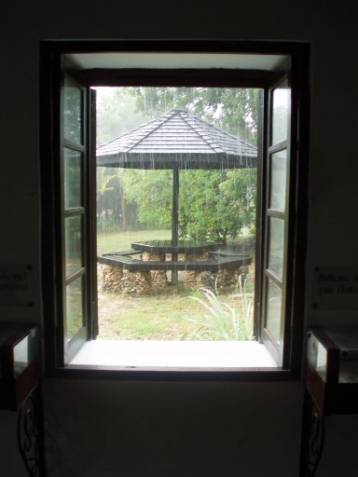
Tropical Rain
We managed to dry out by the time we arrived at our next destination, St Nicholas Abbey. This is one of the two oldest mansions on the island and among only three Jacobean houses surviving in the whole of the Americas (built in 1650). It is a beautiful, elegant house, furnished in European antique furniture. With the rain pattering on the windows and the traditional interior it really felt like we had been transplanted back to Somerset! We were given an excellent guided tour by one of the staff, and told about the house’s fascinating history. The tour ended at the old stables that were now a gift shop, and we were given a sample of the Abbey’s very strong rum. We were also shown an excellent video of old footage filmed by one of the owners of the house in the late 20s of his journey by sea to Barbados and stay on the island. It was fascinating to see how the island looked in its sugar and rum exporting hey day, and get a glimpse into the old colonial lifestyle. In the grounds around the house many of the old plantation building were still standing, including part of the windmill, and a large machinery shed. The shed was full of rusting bits of machinery and a restored steam press which we were told would be operating in the sugar cropping season. It was a fascinating place, which had been sympathetically restored. Well worth a visit.
|
|
|
|
St Nicholas
Abbey |
St Nicholas Abbey Farming
Machinery |
|
|
|
|
Plantation
Buildings |
Steam Sugar
Press |
From the Abbey we drove through the plantation to what we were told was one of the most beautiful spots in Barbados. Cherry Tree Hill provides views across the north of the islands, called Scotland district. We climbed up the steep slippery slope, along a road made of dead coral stone, expecting a breathtaking view which made the climb worth while. It was still blowing hard, and the low clouds made the view rather hazy, though we could see why the place was named after Scotland – it was mostly wet and windy! We took the obligatory photographs then got back into the car, wet again…
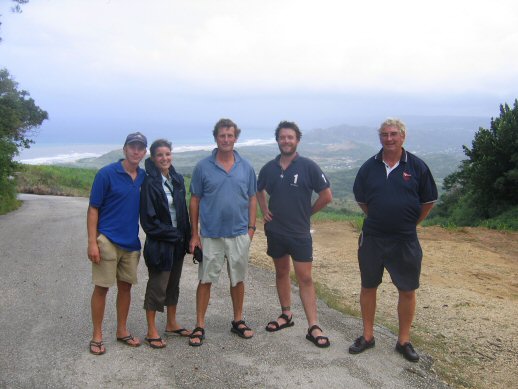
L – R: James G, Amelia, James A, James Jnr, Norfy. Behind is a windswept east coast
By this time we had all had enough of getting wet, so we took the coast road around the south of the islands back to Bridgetown, stopping at a few spots to admire the (wet) view or an interesting building. We arrived back at Carlisle Bay after dark, and were pleased to find that both the dinghies and boats had stayed put in all the strong winds (we had visions of Rahula breaking her anchor and making her own way to Grenada…).
Cleone sailed from Barbados bound for St Lucia the following day, and we were sad to see James A and Norfy go. James Jnr stayed behind to catch his flight back to the UK and had the pleasure of Hotel Rahula for a night – he was chuffed at having a double bed, after sleeping in the saloon bunk on Cleone for 5 weeks. We hung on in Barbados a little longer as the weather still looked pretty unsettled for the sail to Grenada. In our last few days on the island we discovered the Barbados Yacht Club, another old colonial bastion with free membership to visiting yachtsmen. It was a much pleasanter place to sit and drink beer than The Boatyard (and cheaper!), the food was good, and there were showers to wash off the inevitable salt water dunking obtained when landing the dinghy on the club’s beach…
In our penultimate day in Barbados we were also joined by another boat we had befriended in Mindelo. Happy Hours had left Cape Verde a couple of days before us, and arrived 5 days after us. They had a difficult crossing, plagued by calms that slowed their progress. It made us realise how lucky we had been with the weather. We had more celebratory beers with the crew at the yacht club, then it was time to sober up and leave Barbados to catch our flight home from Grenada.
